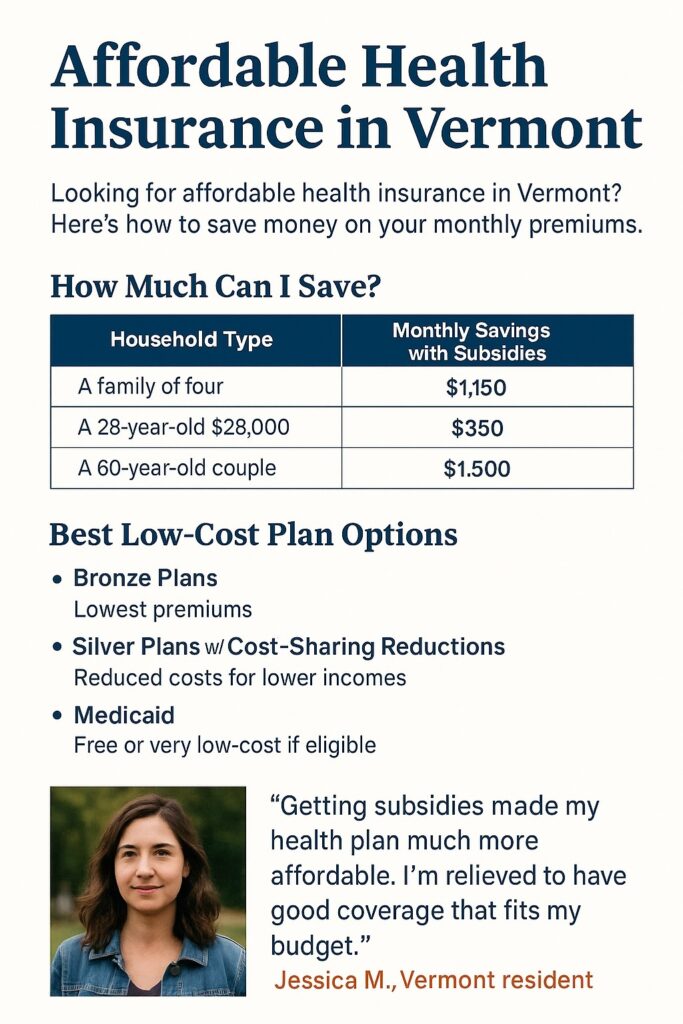Affordable Health Insurance in Vermont

Estimated savings by income level with Vermont Health Connect in 2025
Finding affordable health insurance in Vermont doesn’t have to be overwhelming. Whether you’re a student, self-employed, between jobs, or simply looking to save, there are plans available to fit your needs and your budget. From state subsidies to cost-sharing reductions, Vermont offers several programs that help lower monthly premiums and out-of-pocket costs for residents.
How Much Does Health Insurance Cost in Vermont?
In 2025, the average monthly premium for a Vermont marketplace plan is around $540 before subsidies. However, with income-based assistance, many residents pay significantly less — some even as low as $10 to $50 per month.
- With subsidies: Most people earning under 400% of the Federal Poverty Level qualify.
- Zero-cost options: Some Vermonters qualify for free coverage through Medicaid or Dr. Dynasaur.
- Catastrophic plans: Available for younger adults under 30 or those with hardship exemptions.
What Affects Your Monthly Premium?
Several factors impact how much you’ll pay for health insurance in Vermont:
- Age and tobacco use
- County of residence
- Household income and size
- Plan level (Bronze, Silver, Gold)
- Eligibility for subsidies or Medicaid
Subsidies & Cost-Saving Programs
1. Premium Tax Credits
These lower your monthly premium based on your income. For example, a single person making $30,000 a year might only pay $80–$120/month for a Silver plan.
2. Cost-Sharing Reductions (CSRs)
If your income falls below 250% of the Federal Poverty Level and you enroll in a Silver plan, you may qualify for lower deductibles, copays, and out-of-pocket maximums.
Example Savings by Household Type
- Single adult earning $28,000: Eligible for both APTC and CSR; may pay ~$90/month for a Silver plan with reduced deductible
- Family of four earning $70,000: Likely eligible for a large subsidy; premiums may fall to $250–$400/month total
- Unemployed individual with no income: Likely qualifies for Medicaid at no cost
Medicaid and Low-Income Options
If your income is especially low, you might qualify for Vermont Medicaid or Dr. Dynasaur (for children under 19 and pregnant individuals).
- Medicaid: Available to adults under ~138% of the FPL
- Dr. Dynasaur: Covers children regardless of household income (with premiums based on income)
Best Low-Cost Plan Options in Vermont
- Bronze Plans: Lowest premiums but may come with deductibles over $8,000; ideal for those who rarely use care
- Silver Plans with CSRs: Excellent value if you qualify—some plans have deductibles under $500
- Catastrophic Coverage: For eligible individuals under 30 or with hardship exemptions; premiums can be very low
- Medicaid: Covers preventive care, hospital, prescriptions, and more with little or no cost-sharing
Marketplace Plans vs Private Health Insurance
While most Vermonters use Vermont Health Connect to access subsidized coverage, some may choose private plans directly through insurers or brokers. Here’s how they compare:
- Marketplace Plans: Eligible for subsidies, standardized coverage levels, and regulated enrollment periods
- Private Plans: May offer broader provider networks or plan types like PPOs, but often without financial assistance
If you don’t qualify for subsidies due to income or immigration status, a private plan may offer more flexibility. However, for most residents, marketplace plans provide the best value.
Who Should Consider Low-Cost Plans?
- Freelancers and gig workers: No employer coverage, but may qualify for subsidies
- Part-time employees: Often don’t get job-based insurance and can qualify for affordable marketplace plans
- Early retirees: Need coverage before Medicare; subsidies help reduce high premiums for 50–64 age group
- Young adults: Often qualify for catastrophic or low-cost Bronze plans
- Low-income families: May benefit from both subsidies and Medicaid/Dr. Dynasaur
Real Vermont Resident Story

Real Vermonters are saving hundreds per month on premiums
Jamie L., Brattleboro
“As a freelance designer, I didn’t think I could afford health insurance. But with premium tax credits and a Silver plan, I’m now paying under $100 a month—and my prescriptions are covered. Vermont’s system made it easier than I expected.”
Maria & Sean, Montpelier
“We’re a family of three with fluctuating income. Using Vermont Health Connect, we found a Silver plan with a $0 deductible and a premium under $300. It’s made a huge difference in our peace of mind.”
Explore More Vermont Health Insurance Resources
- Vermont Health Insurance Overview
- Private Health Insurance in Vermont
- Self-Employed Health Insurance Vermont
Frequently Asked Questions
What income qualifies for reduced-cost health plans in VT?
Most people earning under 400% of the federal poverty level can receive tax credits. For a single person in 2025, that’s about $60,240/year.
Is there short-term health insurance in Vermont?
Vermont does not allow short-term health insurance sales. Instead, residents are encouraged to use the state marketplace or Medicaid.
Can I get coverage if I’m unemployed?
Yes. You may qualify for subsidies or Medicaid depending on your income. COBRA is also an option but often more expensive.
Is COBRA considered affordable?
COBRA is typically more expensive than marketplace coverage since you pay the full premium. Most people find better rates through Vermont Health Connect.
Need Help Finding the Right Plan?
Our licensed agents can help you compare affordable plans available in your area. We work with Vermont Health Connect and private insurers to help you find a plan that balances coverage and cost.